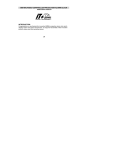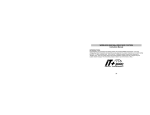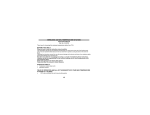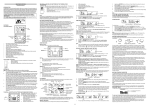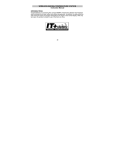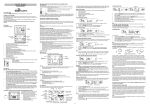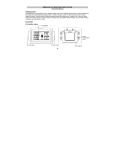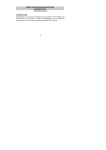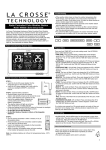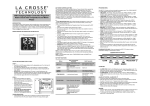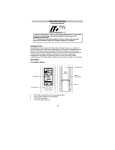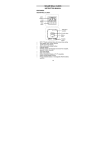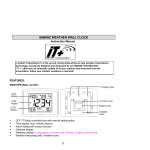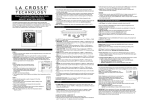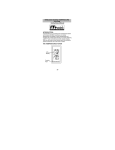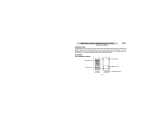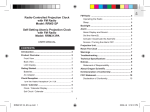Download Ethan Frome
Transcript
WIRELESS 868 MHz TEMPERATURE STATION Instructions Manual INTRODUCTION: Congratulations on purchasing this temperature station with wireless 868 MHz transmission of outdoor temperature and display of indoor temperature, time and date. It is further featuring a DCF-77 radio controlled clock with calendar display. With only four easy to use function keys, this innovative product is ideal for use in the home or office. 38 The temperature station Hanging hole LCD display Battery compartment Function keys Detachable stand FEATURES: TEMPERATURE STATION DCF-77 Radio controlled time with manual setting options Time reception ON/OFF 39 Daylight saving time (DST) function selectable (ON/OFF/AUTO) Time zone option -2h to +5h Weekday, day and month display (year in setting mode) Temperature display in degrees Celsius (°C) Indoor and outdoor temperature display with MIN/MAX recording All MIN/MAX recordings can be reset Low battery indicator Wall mounting or table standing The outdoor Transmitter Remote transmission of outdoor temperature to the temperature station by 868 MHz signal Wall mounting case Mounting at a sheltered place. Avoid direct rain and sunshine 40 SETTING UP: 1. 2. 3. 4. First, insert the batteries in the transmitter (see “To install and replace batteries in the temperature transmitter” below). Within 2 minutes of powering up the transmitter, insert the batteries in the temperature station (see “To install and replace batteries in the temperature station” below). Once the batteries are in place, all segments of the LCD will light up briefly. Following the indoor temperature the time as 0:00 will be displayed. If these information are not displayed on the LCD after 60 seconds, remove the batteries and wait for at least 60 seconds before reinserting them. Once the indoor data is displayed user may proceed to the next step. After the batteries are inserted, the temperature station will start receiving data signal from the transmitter. The outdoor temperature data should then be displayed on the Weather station. If this does not happen after 2 minutes, the batteries will need to be removed from both units and reset from step 1. In order to ensure sufficient 868 MHz transmission however, the distance between the temperature station and the transmitter should not be more than 100 meters (see notes on “Positioning” and “868 MHz Reception”). 41 Note: In the event of changing batteries of the units, ensure the batteries do not spring free from the contacts. Always wait at least 1 minute after removing the batteries before reinserting, otherwise start up and transmission problems may occur. TO INSTALL AND REPLACE BATTERIES IN THE TEMPERATURE STATION The temperature station uses 2 x AA, IEC LR6, 1.5V batteries. If the batteries need to be replaced, the low battery symbol will appear on the LCD. To install and replace the batteries, please follow the steps below: 1. Insert finger or other solid object in the space at the bottom center of the battery compartment and lift up to remove the cover. 2. Insert batteries observing the correct polarity (see marking). 3. Replace compartment cover. 42 HOW TO INSTALL AND REPLACE BATTERIES IN THE TEMPERATURE TRANSMITTER The temperature transmitter uses 2 x AA, IEC LR6, 1.5V batteries. To install and replace the batteries, please follow the steps below: 1. Slide the battery cover downwards and remove. 2. Insert the batteries, observing the correct polarity (see marking). 3. Replace the battery cover. Note: In the event of changing batteries in any of the units, all units need to be reset by following the setting up procedures. This is because a random security code is assigned by the transmitter at start-up and this code must be received and stored by the temperature station in the first three minutes of power being supplied to it. BATTERY CHANGE: It is recommended to replace the batteries in all units on an annual basis to ensure optimum accuracy of these units. 43 Please participate in the preservation of the environment. Return used batteries to an authorized depot. FUNCTION KEYS: Temperature station: The temperature station has four easy to use function keys. SET key + key MIN/MAX key MODE key 44 SET key Press and hold the key to enter the manual setting modes: time zone, time reception ON/OFF, DST ON/OFF/AUTO, manual time, and calendar settings. + key To make adjustment for various settings. MODE key To toggle between the display of "Weekday + date” and “day + month To exit manual setting mode MIN/MAX key To toggle between the current / MAX / MIN indoor and outdoor temperature Press and hold for around 3 seconds to reset all MIN/MAX temperature To exit manual setting mode 45 LCD SCREEN DCF tower Icon (for time reception) Time Calendar Low battery indicator (weather station) Indoor temperature in °C Outdoor reception signal* Low battery indicator (transmitter) Outdoor temperature in °C 46 * When the signal is successfully received by the temperature station, the outdoor transmission icon will be switched on. (If not successful, the icon will not be shown on LCD). The user can then easily see whether the last reception was successful (icon on) or not (icon off). On the other hand, the short blinking of the icon shows that a reception is currently taking place. DCF-77 RADIO CONTROLLED TIME The time base for the radio-controlled time is a Cesium Atomic Clock operated by the Physikalisch Technische Bundesanstalt Braunschweig which has a time deviation of less than one second in one million years. The time is coded and transmitted from Mainflingen near Frankfurt via frequency signal DCF-77 (77.5 kHz) and has a transmitting range of approximately 1,500 km. Your radio-controlled temperature station receives this signal and converts it to show the precise time in summer or wintertime. The quality of the reception depends greatly on the geographic location. In normal cases, there should be no reception problems within a 1500km radius of Frankfurt. The DCF tower icon in the clock display will start flashing in the upper left corner. This indicates that the clock has detected that there is a radio signal present and is trying to receive it. When the time code is received, the DCF tower becomes permanently lit and the time will be displayed. 47 DCF reception is done twice daily at 02:00 and 03:00 am. If the reception is not successful at 02:00 and 3:00 am, then the next reception takes place the next hour and so on until 06:00am, or until the reception is successful. If the reception is not successful at 06:00 am, then the next attempt will take place the next day at 02:00 am. If the tower icon flashes, but does not set the time or the DCF tower does not appear at all, then please take note of the following: Recommended distance to any interfering sources like computer monitors or TV sets is a minimum of 1.5 - 2 meters. Within ferro-concrete rooms (basements, superstructures), the received signal is naturally weakened. In extreme cases, please place the unit close to a window and/ or point its front or back towards the Frankfurt transmitter. During nighttime, the atmospheric disturbances are usually less severe and reception is possible in most cases. A single daily reception is adequate to keep the accuracy deviation below 1 second. MANUAL SETTINGS The following manual settings can be done in the setting mode: Time zone setting Time reception ON/OFF setting Daylight saving time (DST) ON/OFF/AUTO 48 Manual time setting Calendar setting Press and hold the SET button for about 3 second to advance to the setting mode: TIME ZONE SETTING The time zone default of the temperature station is 0h. To change to another time zone: Time zone (flashing) 1. 2. The time zone “0” start flashing. Use the + key, set the time zone. The range runs from –2h to +5h and then runs from +5h to -2h back in 1 hour interval. Press the SET key to confirm and enter the “Time reception ON/OFF setting”. TIME RECEPTION ON/OFF SETTING In area where reception of the DCF-77 time is not possible, the DCF-77 time reception function can be turned OFF. The clock will then work as a normal quartz clock. (Default setting is ON). 49 Flashing 1. 2. The digit “ON” will start flashing on the LCD. Use the + key to turn “OFF” the time reception function. Confirm with the SET key and enter the “Daylight saving time (DST) setting ON/OFF”. Important: If the time reception setting is turned “ON”, only the “ON” or “OFF” selections are available for the daylight saving time setting. If the time reception setting is turned “OFF”, the daylight saving time can only be set to “OFF” or “AUTO”. 50 DAYLIGHT SAVING TIME ON/OFF SETTING (DST) The daylight saving time (DST) function can be set ON/OFF/AUTO. Default setting is “ON”: ON/OFF/AUTO settings: ON: DST will turn “ON” following data update received from the DCF-77 signal (time reception ON). OFF: DST feature is OFF and the clock will not change time automatically. AUTO: the clock calculates DST automatically in normal quartz mode. DST begins on the last Sunday of March and ends on the last Sunday of October. DST icon ON DST icon ON Flashing 51 1. 2. “ON” will flash on the LCD with "dSt" displayed. Use the + key to turn the daylight saving time function ON/OFF or AUTO. Note: the “AUTO” function will automatically turn the daylight saving time function ON only from last Sunday of March and ends on last Sunday of October (preset date). Confirm with the SET key and enter the “Manual time setting”. MANUAL TIME SETTING In case the temperature station is not able to detect the DCF-signal (disturbances, transmitting distance, etc.), the time can be manually set. The clock will then work as a normal quartz clock. Hours (flashing) 1. 2. 3. Minutes (flashing) The hour digit start flashing in the time display section. Use the + key to adjust the hours Press SET button to go to the minute setting. The minutes will be flashing. Press the + key to just the minutes. 52 4. Confirm with the SET key and enter the “Calendar setting”. Note: The unit will still try and receive the signal despite it being manually set. When it does receive the signal, it will change the manually set time into the received time. During reception attempts the DCF tower icon will flash. If reception has been unsuccessful, then the DCF tower icon will not appear but reception will still be attempted the following day. CALENDAR SETTING: The date default of the temperature station is 1. 1. of the year 2012. Once the radiocontrolled time signals are received, the date is automatically updated. However, if the signals are not received, the date can also be set manually. To do this: 1. Year (flashing) Date (flashing) Month (flashing) Using the + key, set the year required. The range runs from 2012 to 2039 (default is 2012). 53 2. 3. 4. Press the SET key to enter the month setting. Use the + key to set the month. Press again the SET key to enter the date setting. Use the + key to set the date. Confirm with the SET key and exit the manual setting modes. INDOOR TEMPERATURE READING The indoor temperature is detected automatically and displayed on the third section of the LCD. Indoor temperature in °C OUTDOOR TEMPERATURE The fourth LCD section shows the outdoor temperature and a reception signal. Outdoor reception signal Outdoor temperature in °C 54 DISPLAY OF INDOOR MAXIMUM AND MINIMUM TEMPERATURE RECORDS: 1. 2. 3. In normal display mode, press the MIN/MAX key once. The MAX indoor and outdoor temperature will be shown in the LCD. Then press the MIN/MAX key one more time, the MIN indoor and outdoor temperature will be shown. Press one more time the MIN/MAX key to go back to the normal display. RESETTING THE INDOOR MAXIMUM/ MINIMUM RECORDS Note: The indoor and outdoor minimum and maximum records will be reset at the same time 1. Press and hold the MIN/MAX key for about 3 seconds, this will reset the indoor and outdoor MIN/MAX temperatures to the current temperature. LOW BATTERY INDICATOR Low battery indicator is displayed on the LCD when the batteries require changing. TEMPERATURE TRANSMITTER The outdoor temperature is measured and transmitted every 4 seconds. 55 The range of the temperature transmitter may be affected by the temperature. At cold temperatures the transmitting distance may be decreased. Please bear this in mind when placing the transmitter. 868 MHz RECEPTION: If the outdoor temperature data is not being received within three minutes after setting up (or outdoor display always show “- -. -” in the outdoor section of the temperature station during normal operation), please check the following points: 1. The distance of the temperature station or transmitter should be at least 1.5 to 2 meters away from any interfering sources such as computer monitors or TV sets. 2. Avoid placing the receiver onto or in the immediate proximity of metal window frames. 3. Using other electrical products such as headphones or speakers operating on the same signal frequency (868MHz) may prevent correct signal transmission and reception. 4. Neighbors using electrical devices operating on the 868 MHz signal frequency can also cause interference. Note: When the 868MHz signal is received correctly, do not re-open the battery covers of either the transmitter or temperature station, as the batteries may spring free from the contacts 56 and force a false reset. Should this happen accidentally then reset all units (see Setting up above) otherwise transmission problems may occur. The transmission range is about 100 m from the transmitter to the temperature station (in open space). However, this depends on the surrounding environment and interference levels. If no reception is possible despite the observation of these factors, all system units have to be reset (see Setting up). POSITIONING THE TEMPERATURE STATION The temperature station may be hung onto wall easily or free standing. To wall mount Choose a sheltered place. Avoid direct rain and sunshine. Before wall mounting, please check that the outdoor temperature values can be received from the desired locations. 1. Fix a screw (not supplied) into the desired wall, leaving the head extended out the by about 5mm. 2. Remove the stand from the weather station by pulling it away from the base and hang the station onto the screw. Remember to ensure that it locks into place before releasing. 57 Free standing With the detachable stand, the weather station can be placed onto any flat surface. POSITIONING THE OUTDOOR TEMPERATURE TRANSMITTER The transmitter is supplied with a holder that may be attached to a wall with the two screws supplied. The sensor can also be position on a flat surface by securing the stand to the bottom to the transmitter. 58 To wall mount: 1. Secure the bracket onto a desired wall using the screws and plastic anchors. 2. Clip the remote temperature sensor onto the bracket. Note: Before permanently fixing the transmitter wall base, place all units in the desired locations to check that the outdoor temperature reading is receivable. In event that the signal is not received, relocate the transmitters or move them slightly as this may help the signal reception. CARE AND MAINTENANCE: Extreme temperatures, vibration and shock should be avoided as these may cause damage to the units and give inaccurate forecasts and readings. When cleaning the displays and casings, use a soft damp cloth only. Do not use solvents or scouring agents as they may mark the LCD and casing. Do not submerge the units in water. Immediately remove all low powered batteries to avoid leakage and damage. Replace only with new batteries of the recommended type. 59 Do not make any repair attempts to the units. Return it to its original point of purchase for repair by a qualified engineer. Opening and tampering with the units may invalidate its guarantee. Do not expose the units to extreme and sudden temperature changes, this may lead to rapid changes in forecasts and readings and thereby reduce their accuracy. SPECIFICATIONS: Recommended operating temperature : +5ºC to +40ºC Temperature measuring range Indoor : -9,9ºC to +59,9ºC with 0.1°C resolution (“OF.L” displayed if outside this range) Outdoor : -39,9ºC to +59,9ºC with 0.1°C resolution (“OF.L” displayed if outside this range) Interior data checking intervals: Indoor temperature : Every 16 seconds Outdoor temperature data checking interval: Every 4 seconds Transmission range : up to 100 meters (open space) Power consumption (Alkaline batteries recommended): Temperature station : 2 x AA, IEC LR6, 1.5V Temperature transmitter : 2 x AA, IEC LR6, 1.5V Battery life cycle : approximately 24 months 60 Dimensions (L x W x H) : Temperature station Temperature transmitter : : 83 x 31,3 x 160 mm 38,2 x 21,2 x 128,3 mm LIABILITY DISCLAIMER: The electrical and electronic wastes contain hazardous substances. Disposal of electronic waste in wild country and/or in unauthorized grounds strongly damages the environment Please contact your local or/and regional authorities to retrieve the addresses of legal dumping grounds with selective collection All electronic instruments must from now on be recycled. User shall take an active part in the reuse, recycling and recovery of the electrical and electronic waste. The unrestricted disposal of electronic waste may do harm on public health and the quality of environment. This product must however not be thrown in general rubbish collection points. As stated on the gift box and labeled on the product, reading the “User manual” is highly recommended for the benefit of the user. The manufacturer and supplier cannot accept any responsibility for any incorrect readings and any consequences that occur should an inaccurate reading take place. 61 This product is not to be used for medical purposes or for public information. This product is only designed to be used in the home as indication of the future weather and is not 100% accurate. Weather forecasts given by this product should be taken only as an indication and not as being totally accurate. The specifications of this product may change without prior notice. This product is not a toy. Keep out of the reach of children. No part of this manual may be reproduced without written consent of the manufacturer. R&TTE Directive 1999/5/EC Summary of the Declaration of Conformity : We hereby declare that this wireless transmission device does comply with the essential requirements of R&TTE Directive 1999/5/EC. 62

























